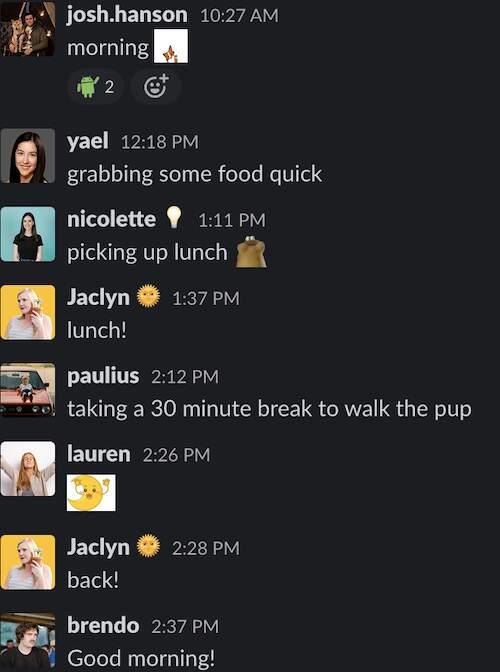Toggling between tabs, hopping in and out of meetings, and juggling multiple conversations at once — sound familiar? It’s what we all do every single day at work without thinking twice ... until we’re hit with a wave of exhaustion when the work day winds down, even if we feel we didn’t accomplish much.
Toggling between tabs, hopping in and out of meetings, and juggling multiple conversations on multiple platforms all at once — sound familiar? It’s what we all do every single day at work without thinking twice ... until we’re hit with a wave of exhaustion when the work day winds down, even if we feel we didn’t accomplish much.
We know multitasking isn’t a sustainable way to work. But there’s a far less talked about consequence of working nonstop, whether you’re trying to multitask or not: context switching, which underscores the immense toll that task switching takes on your brain.
Context switching leeches your productivity, increases stress, and costs you hours of your time, but there are simple shifts you can make to stop for good.
We’ll walk you through how context switching happens, why it’s detrimental to your work, and how you can pave the way for a well-balanced work life, no matter how crowded your calendar is.
What is context switching, and how does it impact your work?
Context shifting, or context switching, is our impulse to switch from one task to an unrelated one. Shifting or switching refers to a change that occurs in our brains when we move from one task to another.
Switching back-and-forth between unrelated projects or having back-to-back meetings might feel like no big deal (especially since all of our work is on the computer these days), but the effects of context switching tend to sneak up on us.
Research shows it takes an average of 23 minutes to regain focus after a distraction because different parts of your brain are activated every time you switch between tasks, even ones as simple as answering a teammate’s question while updating a report or attending a meeting right after another ends. Throw in some Zoom fatigue on top of it all, and you’re totally wiped when you do have a free minute to process your day.
The detrimental effects of context switching are similar to those of multitasking, which has been more thoroughly researched. According to Dr. Clifford Nass, a psychology professor at Stanford University who spent a portion of his career studying the effects of multitasking, the general concept of multitasking is a myth because it’s impossible for us to actually perform multiple tasks simultaneously with the same amount of focus devoted to each one.
Instead, some believe “task switching” is a more fitting term for what we commonly regard as multitasking because we’re constantly redirecting our attention to new tasks instead of performing them at the same time. (The American Psychological Association takes it a step further and suggests we both multitask and task switch to varying degrees.)
For example, having three unrelated meetings in a row isn’t necessarily multitasking, but you are task switching — and context switching — between them.
The bottom line? Humans can’t context switch the same way a computer can (in fact, both context switching and multitasking are originally computing terms), so we can’t expect stellar results when we try.
5 Tangible Costs of Context Switching
Before we look at how to avoid context switching, let me fill you in on five of the most common (and destructive) ways it affects workplace performance.
1. Reduced Productivity
Although some people are better at multitasking than others, it's hard to argue with the data. Research shows that, on average, those who context switch experience a 40% decrease in productivity compared to those who don't.
Let me put that into perspective. Lost productivity due to context switching costs the global economy an estimated $450 billion annually. That's more than the GDP of most countries!
The reason for all this lost productivity? Swapping between different assignments wastes a great deal of time. According to a study from the University of California, Irvine, it takes 23 minutes and 15 seconds to return to your original task after deviating. Three context switches a day, and you've lost over an hour of productivity!
2. Decreased Cognitive Function
Context switching can seriously affect your cognitive functioning, even long term. Studies have shown that frequent context switching negatively impacts working memory, with statistically significant declines among regular multitaskers.
Working memory is essential for nearly every aspect of your job, enabling you to hold and process incoming information. As you'd expect, any decline can hinder your ability to perform quality work. It may also cause lapses in judgment, a potentially catastrophic occurrence depending on the nature of your work.
3. Diminished Attention
The average attention span has dropped by four seconds since the beginning of the 21st century. Researchers say the reason is obvious to anyone paying attention: frequent multitasking.
According to studies, the area of the brain responsible for regulating attention (the anterior cingulate cortex) boasts noticeably less gray matter in frequent multitaskers than in light multitaskers. Researchers believe less gray matter in this region contributes to an inability to concentrate for sustained periods.
The worst part? Humans are creatures of habit, and our brains are the same way. The more we perform tasks in a certain way — e.g., switching back and forth — the stronger our inclination to do so in the future. This leads to a self-reinforcing downward spiral, further reducing your attention span and making it more difficult to reclaim later on.
4. Depleted Energy
You've heard about the brain's left and right hemispheres, and how different tasks activate these different regions. But have you heard that switching between these regions depletes your brain's oxygenated glucose (AKA, its energy reserves)? It’s true — context switching drains your energy faster than sustaining your attention on a single assignment.
The worst part is that once you use up your oxygenated glucose, you have to wait for it to come back. Sure, caffeine and other stimulants can help you regain focus in the interim. But you'll be operating at sub-optimal capacity, prone to making short-sighted errors and mistakes.
"A person who is interrupted while performing a task takes 50% more time to complete it and make 50% more errors." — David Brooks
5. Muddled Priorities
You're busy typing up an important document when a notification pops up in your inbox. It's an email from your boss asking for an update. You begin working on a response when out of the blue, a co-worker walks into your office asking for a favor. You get caught up in a prolonged conversation, and the next thing you know, you're juggling a dozen different tasks without any clear idea about which comes first.
If this sounds familiar, it's because the same situation plays out all day, every day, in offices and among distributed teams across the country. Constant input and subsequent context switching muddles our priorities, making it difficult to distinguish and focus on the right tasks.
Can you relate? If I haven't lost you to another tab yet, let's explore ways you can reduce unnecessary context switching at work.
6 ways to avoid context switching
Even if your schedule is stacked or you’re accustomed to the constant back-and-forth that begets context switching, there are a few methods (no, not “hacks”) you can follow to maximize productivity, avoid mistakes, and enjoy a more stress-free work life.
1. Optimize for focus time.
Focus time and free time aren’t the same; one is structured, while the other isn’t. When you have an open hour or two in your calendar, bring some intentionality into how you use that time to make the most of it.
One study suggests people are most focused when they work for 52 minutes straight, followed by a 17-minute break, because our brains naturally work in hour-long spurts followed by about 20 minutes of rest.
The Pomodoro Technique is a popular time management system that makes it easier to focus on a single task at a time and still knock out different tasks in succession. Here's how it works: you break up your tasks into 25 minute time slots, followed by five-minute breaks to recharge and prepare for the next round (or “pomodoro”). After four pomodoros, you can take a longer, 20-30 minute break.
Whatever ratio works for you, breaking up your day into manageable chunks can help you get — and stay — focused for long periods of time, because there’s no need to peek at your inbox or check social media if you know your next mini-break is less than an hour away.
Of course, not all focus time goes as planned — urgent matters and last-minute requests will pop up. Just gently ease your way back into structured, productive time whenever you can to keep your work moving along.
2. Take real breaks.
No, a lunch break doesn’t just mean eating lunch with one hand while typing with the other (I remind myself of this often). You’re only making your brain work harder. Step away from your computer and savor your breaks.
Even if you only have a small amount of time to spare, use your break time to stretch out, make a cup of coffee, check your phone, rub your dog’s belly, or whatever you need to return to your work feeling motivated enough to power through until your next break.
If you’re feeling pressure to stay ever-present in a remote setting, set your Slack status as away or block out time in your calendar to let your colleagues know you’re unavailable.

This advice also applies to non-work hours and vacations. Enjoy them, and give yourself a much-needed opportunity to recharge and return to work refreshed. You can’t achieve work/life balance if you don’t really have a life. 😁
3. Prepare for meetings ahead of time, every time.
I’m not a big fan of surprises, so I set aside the last half hour of my day to review the next day’s calendar, making note of any meetings I have and reviewing any pertinent agendas to give myself some time to prepare for what’s ahead.
Here at Loom, meeting organizers often record a loom to review the meeting’s agenda and main goals and to discuss any other details necessary for attendees to know before the meeting begins. Because I can increase the playback speed of these looms to 2x, I can go into the meeting feeling informed without having to allocate too much of my own focus time preparing for it.
Preparing for meetings ahead of time is especially helpful on days when I have back-to-back meetings, because I can refer to the list of questions or talking points I drafted the day before, even if I’m winding down from a meeting I had earlier.
Better yet, start declining meeting invites where your presence isn't absolutely necessary. Meetings without a clear agenda can often be replaced with async communication instead.
Related reading: Quick Tips from Loommates: Improve Cross-Functional Collaboration — The Loom Blog
4. Use asynchronous communication to stay in sync.
Asynchronous communication is a communication method that involves a lag between when the sender delivers their message and when the recipient digests it, which is optimal when you’re trying to respect your recipient’s time. Learn about the differences in synchronous vs asynchronous communication.
Defaulting to emails, Slack messages, or video messages (like a loom!) at times that call for asynchronous communication instead of instinctively sending a Zoom invite every time you have a question or want to share an update keeps your calendar clear for deep work instead of clogging it up with meetings.
5. Meditate (or find a way to quiet your mind).
If you’re working from home, it’s tough to keep the not-so-great parts of your personal and professional lives from spilling into one another, leaving your mind constantly buzzing with thoughts that pull you away from your work. Meditation allows you to reset your mind and focus on the present moment, instead of what’s happened in the past or might happen in the future.
If this tip has you thinking “Ummm” instead of “Om,” hear me out. Meditation lowers stress, boosts productivity, and inspires creativity, among a multitude of other scientifically-proven benefits — and you only need to meditate for a few minutes a day to reap the rewards.
Here’s my go-to meditation protocol:
Find a comfortable spot to sit upright, whether it’s your desk chair or on a yoga mat.
Set a timer for two minutes to start (you can increase this over time as you get more comfortable with meditation).
Gently shut your eyes. If your upper body is tense, do a few neck and shoulder rolls to settle in.
Empty out your lungs with a deep inhale followed by a deep exhale to relax your body.
Focus on the sound and movement of your own breath. If any thoughts enter your mind, push them away — you’ll get to them later.
When the timer is up, slowly rise, do a stretch that feels good to you, and ease back into your next task.
You can also look into guided meditation if that’s more your speed. Apps like Headspace offer a ton of different meditation options depending on your preferences.
6. Strategically tackle your to-do list.
Zigzagging between unrelated tasks is downright stressful. Group similar tasks and tackle them in succession to make transitioning to new projects more seamless.
Let’s say you have to:
Gather data for a weekly report in Google Analytics.
Catch up on emails.
Prepare for a meeting with your manager that’s happening tomorrow.
Work on a draft of a blog post for the company blog.
Record a status update loom for an ongoing project.
Read Slack messages from yesterday.
Put together the aforementioned weekly report.
This is how I’d group up these tasks for a more seamless flow between them:
Catch up on emails.
Read Slack messages from yesterday.
Record a status update loom for an ongoing project.
Gather data for a weekly report in Google Analytics.
Put together the aforementioned weekly report.
Work on a draft of a blog post for the company blog.
Prepare for a meeting with your manager that’s happening tomorrow.
The above order is simply my preference, and it’s completely OK if it looks different for you. Group your tasks in whatever way reduces the most friction in your schedule to make for a more blissful workday.
One step at a time
In a world that glorifies hustle culture, remember we’re not actually built to context switch as rapidly as we do. There is no need to juggle. Giving yourself the time and space to work more meaningfully is often easier said than done, especially if you’re used to spinning your wheels day in and day out.
Start with one of the above tips that resonated with you the most and take it from there — you’ll be surprised by how big of a difference a few subtle changes can make.

